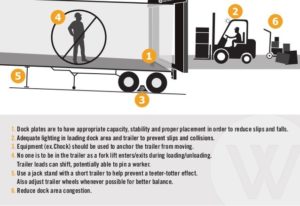June Safety Tip
Loading Dock Safety
Loading Dock Safety
Loading docks are a hub of activity in manufacturing plants, warehouses, industrial buildings and distribution centers. In most companies, this is the primary location of movement of product in and out of a facility. A loading dock is generally a recessed bay in a facility where trucks are loaded and unloaded. Loading docks may be exterior, flush with the building envelope or fully enclosed. Part of a facility’s service or utility infrastructure, loading docks typically provide direct access to staging areas, storage rooms and freight elevators. Loading dock areas can be hazardous, but with the right systems, policies and procedures in place, they can function safely.
Loading Dock Hazards
Loading docks have an increased potential for serious injury, the following are just a few of the more common hazards associated with loading dock areas:
- Wet, oily, or broken floor surfaces
- Unguarded dock edges
- Unsecured dock plates
- Unchocked trailer wheels
- Carbon monoxide exhaust
- Handling large, heavy, awkward loads
- Powered industrial trucks
- Trailer separation
Helping to Make Your Dock Safe
With so many moving pieces potentially in play, ensuring loading dock safety in the workplace can be a challenge. A safety checklist is a simple yet effective tool to help establish a foundation for a safe loading dock area. The sample checklist below collects tips and practices from OSHA and the other resources listed at the bottom of the page. It’s one starting point for improving loading dock safety.
- Make sure all personnel are trained in dock safety and that rules are enforced.
- Ensure that locking devices are used on every vehicle at a dock.
- Protect pedestrians by ensuring they are aware of powered industrial trucks in use. Pedestrians must be mindful, cautious and realize that powered trucks may, improperly, neglect to yield to them.
- Mark floors with yellow tapeor paint to identify walkway barriers, doorways, parking aisles and overhead obstacles.
- Protect people traveling through your facility from sharp corners and from falling off dock edges – place padding or guardsaround sharp corners and dock barricades on open dock edges.
- Put an inspection program in place to review palletized materials. If pallets are defective, the product should be moved to a safe pallet.
- Review warehouse ergonomics. Adjust the height of conveyors to eliminate lower back stress. Place heavier products at knee- to chest-high levels. Limit the amount of weight a worker must carry and allow for assisted lifting from other workers.
- Install guards on conveyor sprockets, gears and rollers. All pinch points must be protected and labeled.
- Use plasticor metal banding to secure product to pallets for transportation or storage.
- Shrink-wraploose product for transport or storage. It is very important to secure small items that might fall through the overhead guard of a lift truck.
- Clean out dock areas periodically to remove accumulated debris.
- Only allow trained and authorized employees to operate powered industrial trucks.
- Inspect the dock area daily to ensure that emergency equipment is not blocked or damaged.
- Paint the dock edge a reflective yellow to provide a better view of the dock.
- Verify that laddersfrom the dock floor to the dock meet OSHA specifications.
- Ensure proper illuminationfor exit routes.
- Identify and markoverhead hazards such as pipes, doors and electric wires.
- Prohibit dock jumping, which can lead to serious ankle, knee and back injuries.
- Make sure that dock plates and boardsare designed for the loads and lift trucks used.
- Always inspect the floors of trailers and trucks before a forklift or pallet jack is driven onto them.
- Always inspect the landing gear and place trailer stabilizing jack standsunder trailers that are spotted at a dock.
- Always make sure dock levelers are returned to a neutral position after being used – this eliminates a “void in the floor” and helps prevent forklift incidents.
- Provide a dock seal or dock shelter to keep rain and snow off loading docks which can cause slippery surfaces.
Wheel Chocks and Rear Impact Guard Locking Devices
One common loading dock accident occurs when drivers mistakenly pull away while a powered industrial truck is still inside the trailer. Another frequent problem is “trailer creep,” which happens when trailers gradually move away from the dock because of the ongoing impact and momentum of forklifts entering and exiting them. Standard practice has been to use wheel chocks to prevent this from happening but rear impact guard (RIG) locking devices have since proved to be the better solution. Chocks have been found to provide insufficient pullout resistance.
They may slip on the ground and placing the chocks presents a hazard in itself to the employee. Chocking also lacks an embedded communication system to let the truck driver, powered industrial truck operator and dock personnel know they are in place. In March of 2011, OSHA provided an interpretation on the chocking requirement found in 29 CFR 1910.178(k)(1) and (m)(7). The interpretation states that chocking will not be enforced for Commercial Motor Vehicles (CMV) that fall under the enforcement of the Federal Motor Carrier Safety Administration (FMCSA) but will still be enforced for non-CMVs (not regulated by FMCSA).
Dock Boards
Dock boards are used to bridge the gap between the truck trailer and the loading dock so that pallet jacks or forklifts may move product in and out of the trailer. Employees should be trained on the proper and safe use of dock boards. Poorly placed dock boards may cause the forklift and or loads to overturn. Dock boards are generally portable but typically require the use of a forklift to move them. They are used in most industrial and heavier load environments.
Dock Plates
Dock plates are a smaller and more portable equivalent of the dock board. They may be constructed of aluminum, steel or polyethylene and do not have the weight capacity of the dock board. When using hand trucks or pallet trucks, a dock plate may be in order.
Dock Levelers
Dock levelers are items that also bridge the gap between loading docks and trailers; however, the dock leveler also helps correct the height difference between loading docks and trailers. Dock levelers are permanent devices that are operated either by hand (mechanical) or by hydraulics.
Dock Signaling Devices
A technology that is available is the use of signaling devices that indicate that a person or powered industrial truck is in the trailer or that the trailer is properly secured and forklift traffic can enter the trailer.
Guarding
Guarding devices are essential to loading dock safety. Examples of guarding devices are guard rails, bollards, dock barricades and stops. Guardrails being used to separate pedestrian traffic from the production traffic in loading dock areas is a good best practice. They can also be used in open docks with no trailer to prevent personnel from falling off the dock edge. In addition, guard rails can be used to protect stationary equipment or machinery and structures from accidental impacts from forklifts.
Bollards serve much the same purpose but are used to protect building corners or where space around an area is limited. When placed correctly the bollard will keep a forklift from damaging a structure more severely. Another guarding item commonly found are stops. Stops are steel plates placed along raised locations in a warehouse or loading dock intended to keep personnel and forklifts from falling over the edge of a raised area.
Commonly Asked Questions
What are the primary differences between a dock board and dock plate?
A dock board is constructed of steel or aluminum, has side curbs, lifting chains or loops, locking pins or legs, and weight capacities of 10,000 pounds (lbs.), 15,000 lbs., and 20,000 lbs. The dock plate can have many of the same features but will have considerable lower weight capacities and may be able to be moved by hand. Most dock plates do not have safety curbs or locking pins and are recommended only for non-powered loading and off-loading of material.
Is the employer responsible to ensure the forklift operator is not in the trailer when the driver attempts to pull away from the dock?
In most cases yes, unless Federal Motor Carrier Safety Administration (FMCSA) regulations apply.Then an employer must comply with OSHA’s standards to ensure that forklift operators are not in the trailer when the driver attempts to remove the trailer from the loading dock. The powered industrial truck standard (29 CFR 1910.178) requires that the PIT operator be trained not to operate a PIT on a trailer that has been backed to a company’s dock, unless the trailer is properly secured or restricted from movement prior to boarding.
Sources
29 CFR 1910.176: Handling Materials
29 CFR 1910.178: Powered Industrial Trucks
29 CFR 1910.22: General Requirements
ANSI/ITSDG B56.1-2016 Safety Standard for Low Lift and High Lift Trucks
Powered Industrial Truck eTool: Understanding the Workplace: Loading Docks
Interpretation Letter to Mr. Ron Cole, Occupational Safety and Health, March 7, 2011
OSHA Worker Safety Series – Warehousing

